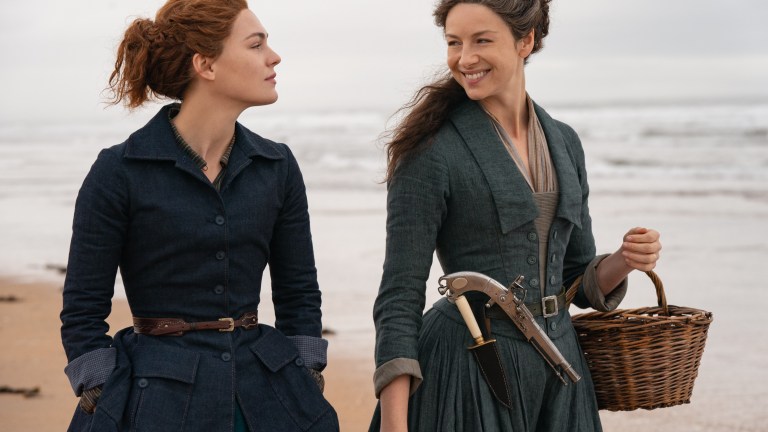Outlander Season 5 Episode 10 Review: Mercy Shall Follow Me
The Mackenzies and Frasers finally have a showdown with Stephen Bonnet, but the sociopath smuggler finds new ways to attack in this week's Outlander.

This Outlander review contains spoilers.
Outlander Season 5, Episode 10
“Mercy Shall Follow Me” features the Frasier-Mackenzie confrontation with the dreadful Stephen Bonnet. Fans have been waiting for this inevitable clash. However, the presentation of the confrontation in the script raises questions of historical veracity as well as Outlander’s continued reliance on exploiting rape trauma for shock value.
The episode begins in Wilmington, with Jocasta’s lawyer Forbes and Bonnet chatting openly in a tavern about murdering Jocasta and Duncan Innes and defrauding River Run. Forbes has sent a backhander to the magistrate and secured witnesses to attest to Bonnet being Jemmy’s father. Forbes also advises Bonnet that he is hearing rumors about involvement in sex trafficking and that it may undermine their plans. It’s clear Jamie’s trap for Bonnet did not take into account the extent of his dealings. This conversation also sets the stage for the most troublesome development in the episode.
Meanwhile, in another establishment, the Frasers and Mackenzies are carefully plotting their approach to Wylies’ Landing. Ian trades in his Mohawk attire for a sharp green suit set and tricorn hat to pose as Alexander Malcolm. Bree and Claire already suspect Wylie may be up to no good, but their part in the plan is to wait for the men to return to town. They have their own mission to find better supplies for syringes.
The whiskey smugglers are one step ahead of Ian, Roger, and Jamie, as henchmen demand to inspect the barrels. The henchmen, of course, have no idea Bonnet is busy stalking Claire and Bree’s trip to the beach for shells to file down. He waits for Bree to separate from Claire to hold her hostage and drag her away to his house.
Bree once again has to face her abuser, and Bonnet brings fresh doses of sociopathy, gaslighting about a “happy” relationship in the future and sob stories about his childhood. Annie Griffin’s staging plus Sophie Skelton and Ed Speleers’ performances force the audience to keep their eyes on the screen, no matter how much they are repelled by these scenes. Viewers feel just as scared as Bree does when she pretends to read Moby Dick. Bonnet’s obsession with becoming a gentleman leads him to force Bree into giving dinner etiquette lessons. The sole upside to this conversation is that Bree openly acknowledges slavery is an essential part of life at River Run. She manages to evade Bonnet’s sexual advances through her first night in captivity but the morning brings a new round of trauma.
The most disturbing scene in this sequence is when Bonnet calls in Eppie for sex and forces Bree to watch. Eppie then fails to help her escape the house. Ed Speleers will likely become just as hated as Tobias Menzies was in earlier seasons as Black Jack Randall, however, this is a testament to just how convincing he is portraying Bonnet’s violent tendencies.
In between Bonnet’s psychological torture, Forbes attempts to carry out the murder plot at River Run. Jocasta at first believes Forbes is noting all of the changes to her will but he becomes violent as he realizes his profit margin is disappearing. He tries to suffocate Jocasta but Ulysses saves the day with a powerful chokehold.
Back in Wilmington, Roger has Phillip Wylie by the throat to find out where Bonnet took Bree. He points the way to the brothel Bonnet frequents for information. Claire turns the culture of silence into information on Bonnet’s house on Ocracoke Island after an on-the-fly diagnosis of the brothel owner’s hip disorder. Just as the family finds out where Bree is, Bonnet escalates the torture once again and sells Bree to a pimp named Captain Howard for six pounds. She is dragged back to the same beach as the abduction to be taken away when Roger, Jamie, Claire, and Ian find her. Bonnet is beaten and shot at while Captain Howard escapes. All of the witnesses Forbes planned for the paternity suit were used off-screen to convict Bonnet on piracy and other crimes.
Although the most traumatic scenes throughout this episode have top-notch acting and directing, the adaptation of Bonnet’s death from the book exposes Bree to more rape trauma not present in the novel. There are references in the books to Bonnet frequenting brothels, and he’s involved in smuggling. Bree is also abducted in the novel as part of the plan for Bonnet to establish himself as owner of River Run. The logic for extending Bonnet’s villainy into human trafficking is sound but results in unfortunate implications. Especially in comparison to the sex-positive depiction of 18th-century sex work on Harlots, “Mercy Shall Follow Me” appears incredibly regressive and possibly a distortion of history.
Book fans may believe a stricter interpretation of the novel would sidestep Bonnet’s voyeurism. However, fans must also concede Season 5 faced logistical issues with actor availability and time constraints. The River Run characters and Bonnet cronies involved with the gold theft and inheritance scam were already erased from the show. In addition, book based fan arguments frequently ignore or make excuses for the rape tropes in the novels.
The conclusion of “Mercy Shall Follow Me” allows Bree to have her own chance for revenge. Bonnet is sentenced by the court to drown while chained to a wood pole. Bree shoots Bonnet, ensuring his death. The ending presents a conundrum for the final two episodes of the season. Will Wylie actually hold true to making himself scarce? Will Ulysses be prosecuted for killing Forbes? Is there another previously-unseen element that will dominate the last two episodes of the season? With only two episodes left in the season, we’re about to find out.
Other Comments.
- The costumes of the sex workers and tavern workers are somewhat questionable in terms of 1770’s patterning. The off-the-shoulder dresses without shawls/fichus, stays (corsets) with more “push up” boning, and the Polonaise gowns (cinched overskirt) are anywhere between a decade and 70 years ahead of fashion.
